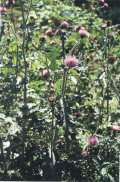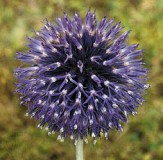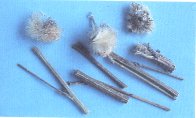Thistle
http://www.100md.com
《e Natural Health Center》
 |
 |
 |
 |
Hemostatics
Thistle
Latin:
Herba seu Radix Cirsii Japonici
Origin:
The part above the ground or root of Cirsium japonicum DC., a perennial weed, of the family Compositae.
The word thistle most often refers to prickly leaved species of Carduus and Cirsium, which have dense heads of small, usually pink or purple flowers. Plants of the genus Carduus, sometimes called plumeless thistles, have spiny stems and flower heads without ray flowers. Canadian thistle (Cirsium arvense) is a troublesome weed in agricultural areas of North America, and more than 10 species of sow thistle (Sonchus) are widespread throughout Europe. Some species of globe thistle (Echinops; see photograph ) are cultivated as ornamentals. The thistle is the national emblem of Scotland.
, 百拇医药
Thistle grows to about 1 m high. It is in flower from August to September, and the seeds ripen from September to October. The flowers are hermaphrodite (have both male and female organs) and are pollinated by bees, flies, moths, butterflies and beetles. The plant cannot grow in the shade. It requires moist soil.
Thistle is grown in most areas of China. The part above the ground is cut off when the flower blooms in summer or autumn or the root is dug out at the end of autumn. Remove impurities from the part above the ground or the root and dry in the sun for use when raw or after being parched.
, http://www.100md.com
Properties:
Bitter and sweet in flavor, cool in nature, it is related to the heart and liver channels.
Functions:
Removes heat from the blood to stop bleeding, dissipates blood stasis, eliminates toxic substances and cures boils.
Applications:
1. To treat bleeding syndromes due to blood-heat:
, http://www.100md.com
Cold or cool in nature and entering the blood system, this herb can remove heat from the blood to stop bleeding. It is used for bleeding syndromes due to blood-heat such as hemorrhoidal bleeding, hemoptysis (expectoration of blood from some part of the respiratory tract), epistaxis (nosebleed), metrorrhagia (profuse uterine bleeding especially between menstrual periods) and hematuria (blood in the urine), etc. In particular, it is used more for cases of hematemesis, hemoptysis, metrorrhagia and metrostaxis.
, http://www.100md.com
It can be used alone or together with field thistle (Herba Cephalanoploris), oriental arborvitae twig and leaf (Cacumen et Folium Biotae), etc.
2. To treat carbuncles and swelling due to toxic heat:
This herb can be used alone, with the fresh herb being best for use. It can also be used in combination with other herbs that clear away heat and toxic substances.
3. To treat hepatitis, hypertension, etc.:
, http://www.100md.com
It has produced certain curative effects in recent years when used for the treatment of hepatitis, hypertension, etc.
Dosage and Administration:
10-15 g., double the dosage when using fresh herb.
Decoct for oral administration. Use an adequate amount externally by mashing and applying onto the affected part.
Cautions on Use:
, http://www.100md.com
Reference Materials:
'Other Medical Records of Famous Physicians' :
"To treat leukorrhea with reddish discharge, hematemesis, epistaxis, and preventing miscarriage."
'On Properties of Herbs' :
"Arresting metrorrhagia and metrostaxis by blending the raw root into juice and the bleeding will mostly be stopped as soon as about 500 ml of the juice are taken."
, 百拇医药
'Annotation on Shen Nong's Herbal Classic' :
"Thistle is the most capable of removing heat from the blood and all the symptoms will be relieved by themselves after the blood-heat is removed."
Toxic or Side Effects:
Modern Researches:
The whole herb contains alkaloids, volatile oil, amaroid, etc.
, http://www.100md.com
Parched thistle can shorten bleeding time.
This herb can inhibit Mycobacterium tuberculosis hominis.
The leaf is haemostatic (stops bleeding) and diuretic.
The stem is haemostatic.
The roots are antiinflammatory, diuretic and haemostatic., http://www.100md.com